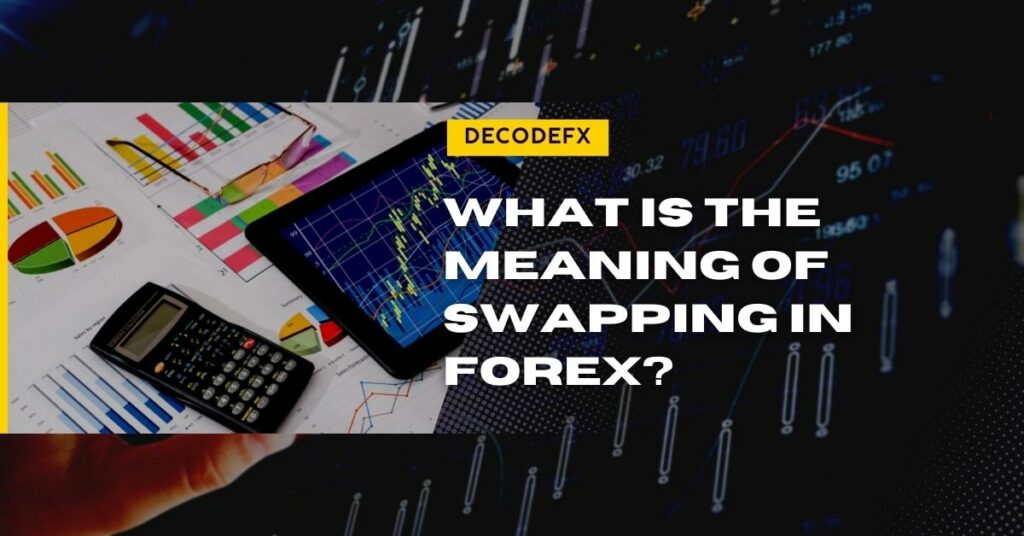What is Forex Trading?
Forex trading is the simultaneous buying of one currency and selling of another. Currencies are traded through a broker or dealer and are traded in pairs. For example, the euro and the U.S. dollar (EUR/USD).
What Does Swapping in Forex Trading Mean?
Swapping in forex trading means that when you buy a currency pair, you are actually borrowing one currency to buy another. The broker will then swap or roll over the position overnight so that you don’t have to deliver the currency back until the next day. Swapping allows traders to hold onto their positions for longer periods of time, which can result in greater profits if successful.
Swap is simply the interest rate differential between the two currencies you are trading. If the interest rate of the currency you are buying is higher than the interest rate of the currency you are selling, then you will earn swap. If it is lower, then you will pay swap.
Simply put, you can pay swap or earn swap for holding positions overnight. Whether you pay or earn depends on the specific currency pair you are trading.
How to Calculate Forex Swap?
To calculate a forex swap, you simply multiply the interest rate differential by the value of your trade. For example, if you are buying EUR/USD and the interest rate differential is 0.03%, and your trade size is $100,000, then your daily swap will be $30 (0.00030 x 100,000).
Types of Swaps in Forex Trading
Positive Swap
This is when the interest rate of the currency you are buying is higher than the interest rate of the currency you are selling. In this case, you will earn swap.
Negative Swap
This is when the interest rate of the currency you are buying is lower than the interest rate of the currency you are selling. In this case, you will pay swap.
Short-term Swap
This is when the interest rate differential between the two currencies is small. A short-term swap is usually only a few pips.
Long-term Swap
This is when the interest rate differential between the two currencies is large. Long-term swap can be many pips.
Factors to Consider While Using Swap in Forex
When deciding whether or not to use swap in your forex trading, there are a few factors you need to consider:
Your trading strategy
If you are a day trader or scalper, then swap is not likely to be a factor in your decision-making. However, if you are a swing trader or position trader, swap can impact your profits or losses.
The currency pair you are trading
Some currency pairs have large interest rate differentials, while others have small ones. You need to take this into account when deciding whether or not to use swap.
Your risk tolerance
Using leverage can increase your profit potential, but it can also increase your losses. You need to make sure you are comfortable with the amount of risk you are taking before using swap.
The costs of swapping
There are always costs associated with using leverage, and swapping is no different. You need to ensure that the potential profits you aim for are greater than the costs of swapping.
As you can see, there is a lot to consider when it comes to using swap in your forex trading. However, if used correctly, swap can be a powerful tool that can help you increase your profits. Just make sure you understand the risks involved before using it.
3 Reasons why Traders Swap in the Forex Market
There are a few reasons why traders swap in the forex market;
- To hedge their positions: If a trader is holding a long position in a currency pair, they may want to consider swapping to hedge their position. This means that if the market moves against them, they will still earn interest in their trade. In other words, you can hedge your trade position for long periods by paying swap fees to keep the positions open.
- To take advantage of interest rate differentials: As we mentioned earlier, if the currency you buy is higher than the interest rate of the currency you are selling, you will earn swap. This can be a great way to increase your profits.
- To hold onto their positions for longer periods: Swapping allows traders to hold onto their positions for longer periods, which can result in larger profits.
Costs of Swapping in the Forex
While swaps can be a great way to increase your profits, it’s important to remember that there are always costs associated with using leverage. These costs can eat into your profits, so it’s important to take them into account when deciding whether or not to use swap in your forex trading. Some of the main costs of swapping include;
The interest rate differential
This is the main cost of swapping, which is the difference between the interest rate of the currency you are buying and the currency you sell.
The spread
You will always have to pay a spread when you trade with leverage. This is the difference between the bid and ask price of a currency pair.
The commission
Some brokers will charge a commission for using swap, so this is something else you need to take into account.
As you can see, a few costs are associated with using swap in your forex trading. However, if used correctly, these costs can be easily offset by your trades’ profits.
Swapping can greatly increase your profits in the forex market, but it’s important to understand the risks involved before using it. Make sure you consider all the costs associated with swapping before deciding whether or not to use it in your trading strategy.
Find out more about currency swaps and Forex trading in general with Decode Global
Now that you know how the swap works in forex, you can open a forex trading account on Decode Global and start taking advantage of the low swap fees offered on our platform. We provide the best possible trading conditions for you to maximize your long-term and short-term trades easily.

